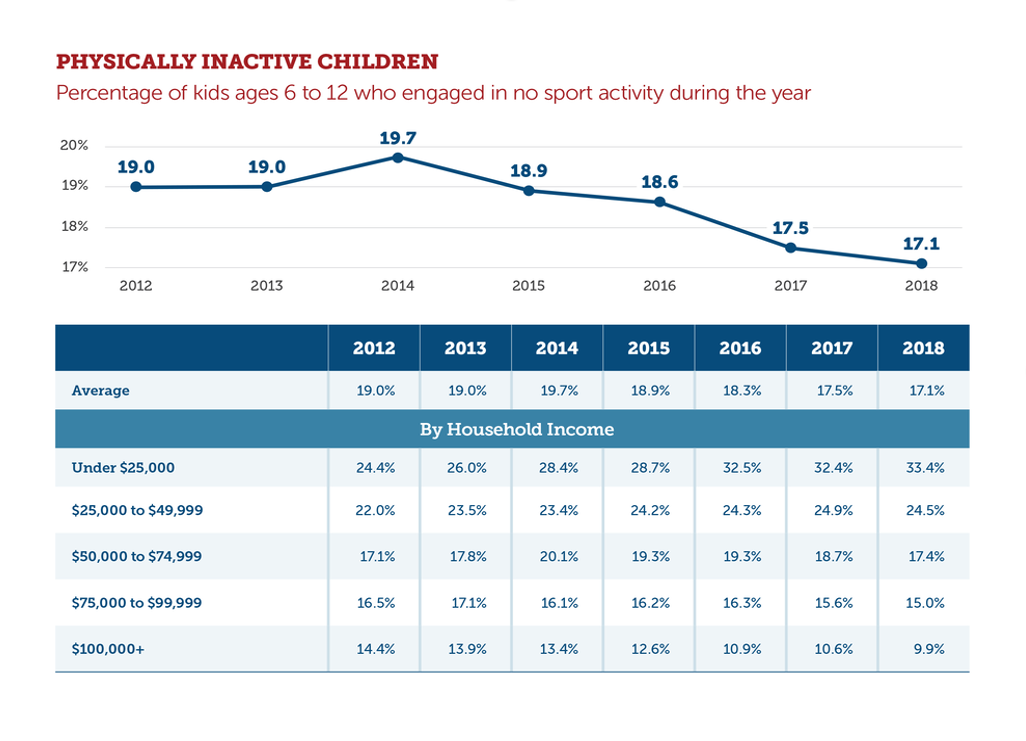The Social Benefit from Sports Betting -- Funding Sports-Based Youth Development Programs for Underserved YouthBefore the pandemic shut down the world in March 2020, participation in youth sports, particularly for low-income children, was woefully inadequate in the U.S. As the chart below from the Aspen Institute’s Project Play shows, youth from households with income under $25,000 are 3 times as likely not to participate in a sport as youth from household income over $100,000+. Further, a 2020 national survey conducted by the Youth Sports Collaborative Network (YSCN) of 82 nonprofits providing sports for free or a low fee to 146,000 low-income youth in March 2020 found that 84% of these youth were no longer participating by September. In early April of this year, the state of New York became the first state to allocate a portion of tax revenue from mobile sport betting to support “a statewide youth sports activities and education grant program for the purpose of providing annual awards to sports programs for underserved youth under the age of eighteen.” The information that follows shows why New York’s actions is a good policy for the citizens of New York and all other states.
The U.S. Has an Obesity Problem – The U.S. National Center for Health Statistics released a report on national weight gain that showed an increase among men by 8 lbs and women by 7 lbs from 2000 – 2016. Further, a 2018 study by the American Academy of Pediatrics showed overweight and obesity rates increased among children ages 2 to 19 between 1999 and 2016 – with 41.5% of teens obese by 16 to 19 years old. This study further reports that African American children, Hispanic children, and children of other races have a higher rate of obesity than White and Asian American children. America’s Youth Get Insufficient Exercise – In a 3-year study of self-reported physical activity among youth, only 5.2 percent of children reported meeting the daily goal of 60 minutes for physical activity. In addition, 49.6 percent were insufficiently active, and 5 percent reported no physical activity at all. Not surprisingly, research from the Centers for Disease Control and Prevention shows that youth obesity is higher for low-income children than those of the highest income. Health Benefits of Youth Sports – People with obesity have an increased risk for high blood pressure, high cholesterol, cardiovascular disease, heart disease, type 2 diabetes and cancer. A computer model from the Global Obesity Prevention Center (GOPC) at Johns Hopkins University determined in a study published in Health News that if all current 8 to 11-year-olds in the U.S. did 25 minutes of exercise just 3 times a week, it would result in 1.2 million fewer youth who are overweight or obese, which would save $62.3 billion in medical costs and lost wages during their lifetimes. Solutions for Underserved Youth – Over the past two decades, there has been a steady growth of 501c3 nonprofit organizations throughout the U.S. dedicated to combating this lack of sports and fitness programs for low income children. There are hundreds of sports-based youth development (SBYD) organizations using the delivery of sport intentionally and primarily to achieve positive non-sports-based outcomes such as teamwork, respect for one’s opponent and academic success by providing low-income children a variety of sports and fitness programs. These programs often include additional youth development services such as academic enrichment, employment training, civic engagement, health and nutrition guidance, and trauma therapy. The youth in these after school programs see measurable improvements in BMI scores, fitness, grades and school attendance. These SBYD nonprofits vary in size – from a program of a dozen children in one location, to others offering their program in several U.S. locations to hundreds, and even thousands, of children. Insufficient Funding – These SBYD programs are financially self-sufficient through a range of fundraising sources. In YSCN’s 2020 national survey, the top 3 challenges before COVID were new sources of funding, including more children, and maintaining current sources of funding. During COVID, the new sources of funding fell to #2 and current funding to #4, with connecting with youth #1 and engaging youth virtually #3. Survey also found among 11 funding sources listed, the top 5 selected were foundation grants, individual foundations, Board donations, events, and corporate sponsorships. State government grants were #10 and federal grants #11. Allocating State Sports Betting Revenue for Youth Sports -- Sports and fitness programs are essential for all children, not just for those who can afford them. Sports betting is a “once in a generation opportunity” to provide sports access to all children, explains Tom Farrey, executive director of Aspen Institute’s Sports and Society Program. We all benefit with sports for all youth. |



